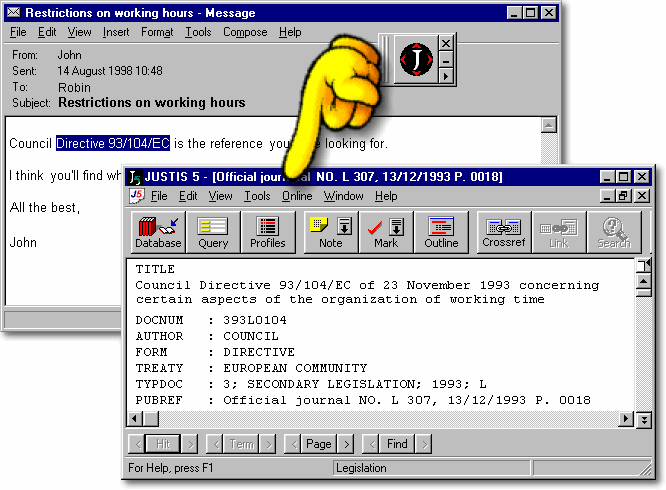
Linking European Union Legislation & Case Law
Nicki Lane, Context Ltd
May 1999
Good afternoon ladies and gentlemen,
I’d like to start with a very brief introduction. Context is an electronic publishing company. We publish a range of CDs, online and Internet titles covering UK and EU legislation and case law as well as business information.
As the title of my talk suggests, I intend to concentrate on the linking facility of Context’s software rather than the databases themselves. I will demonstrate how the JUSTIS 5 software can enable faster and more flexible research. And with the new development of floating J-Link, how you can link your own information directly to full text documents running under JUSTIS. You will be able to create a seamless source of EU information for your organisation.
The database I shall be using is JUSTIS CELEX. Full details of these and other databases can be found in the exhibition, but briefly….
JUSTIS CELEX
CELEX is the official legal database of the European Communities. It's content and structure reflects the legal entity of the European Union. It provides the source texts of EU law from all the major institutions of the EU. CELEX also gives an insight into the interaction between these institutions, both in the creation of legislation and the judgments which interpret it. CELEX is an essential tool for anyone who has to take into account EU legislation in their work.
CELEX is a vast database containing the series of treaties, which form the primary legislation of the EU, the secondary legislation, in the form of directives, decisions & regulations etc, proposals for future legislation, the decisions of the European Court of Justice and questions asked in the European Parliament.
These distinct but interdependent components are organised in separate databases and this enormous and sophisticated database is increasing by over 7000 documents a year. That is about 144 documents a week.
In addition, about 30-40% of new legislation amends previous pieces of legislation. So you can imagine that cross-referencing is very important. Indeed, CELEX does have an extensive cross-referencing system which enables you to track the progress of any piece of legislation. For example, starting from the proposal itself, through its consultative stages until it becomes an active directive or regulation. It is also possible to follow any case law arising out of any directive.
Context’s J-Link technology allows you to maximise the use of these hundreds of thousands of cross-references within the CELEX database. J-Link will enable you to quickly link back and forth avoiding the need for any unnecessary searching!
Using J-Link within JUSTIS 5
J-Link allows cross-referencing within the same database and between different JUSTIS databases.
For example, you can link from the bibliographic database held on JUSTIS European References CD-ROM to a European Community directive in JUSTIS CELEX. To do this you would simply highlight the reference and click the J-Link button on the toolbar. It doesn’t matter that the documents exist in separate databases.
Demonstration
JUSTIS European References CD-ROM
JUSTIS CELEX CD-ROM – Legislation database
JUSTIS CELEX CD-ROM – Case Law database
More remarkably, however, J-Link allows you to link from external sources.
Using J-Link from external sources
I’d like to introduce the most exciting element to this new technology - the fact that it also works outside the JUSTIS databases. This means you can exploit the many citations within your other applications.
Users run a very small memory resident program that puts a floating J-Link icon on your Windows desktop.

When reading text in an e-mail or word document you may see a publication reference, to a European directive for example. You will be able to call up the full text of that document almost instantly. Just by clicking the J-Link icon on your desktop.
J-Link allows references in virtually any database, word processing file, even e-mail or a Web site, to automatically link to the JUSTIS range of databases. The "soft hypertext" linking technique, which J-Link introduces, has important implications for all users of electronic information.

Demonstration - J-Link will take you from:
This is by no means an exhaustive list. J-Link will work from most Windows applications, including word processors, e-mail, Intranets and the Internet, provided you subscribe to the relevant JUSTIS database.